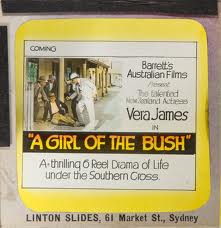
GIRL OF THE BUSH
Australia, 1921, 90 minutes, Black and white.
Vera James, Jack Martin.
Directed by Franklyn Barrett.
Girl of the Bush is a popular film made by Franklin Barrett (Breaking of the Drought) at the beginning of the,'20s. While it had a routine story used very often in Australian films (The Squatter's Daughter), it also had excellent documentary-style sequences of life on the land, farming, treatment of sheep, shearing. It must have made quite some impact at the beginning of the '20s.
The film idealises the country and its way ill: life, criticises the temptations of the big city. The characters are obviously good and evil - some rather based on drawing room comedies and dramas and the 19th. century styles. However, the cast brings the characters to life, especially a vigorous Vera Day, an actress from New Zealand who tried working in Hollywood for some tine.
Of particular interest in retrospect is the presentation of the Chinese man and woman working on the farm - they provide the corny comedy as well as opportunities for some rather White Australia sub-titles. Aborigines are also presented - and the film is set in 1920 - as threatening 'civilisation', attacking whites and killing them.
The film carries the audience with interest as they allow for the filmmaking styles of the '20s. It is also an opportunity to look at how Australia was seen by film-makers at the time.
1. An interesting film of 1920? The state of the industry at that. period? Techniques of photography, silent film-making? its accomplishment?
2. 1920 and themes: the bush, the contemporary setting, relationships between men and women, work opportunities for men and women, the country, the English influence, the aborigines, the Chinese, morals, justice, the city and gambling?
3. The quality of the titles:- the drawings accompanying them, the language, tone e.g. the Never-Never?, the slang-used, the racist tones, the deference towards England?
4. The quality of the documentary footage: the farms, driving, the sheep, the shearing?
5. The conventions for the characters and action, 1920 style? Artificial?
6. Lorna: her background, found, in the family and fathered by Jim Keane, work on the property, clashes with Oswald, her work and success, taking over the property, the attraction towards Tom Wilson, the finding the baby, the blacktracker working out what had happened, taking care of the baby, Oswald concealing her letters, the court case for Oswald's death, Tom Wilson accused, his believing the worst of her, her being hurt, the reconciliation? The image of the successful Australian woman?
7. Oswald Keane, the pioneer, the father of the family? Relationships with his staff? Work on the property? Disdain of Oswald - and the notes and the sheep-rustling? His death and not leaving the property to Oswald?
8. Oswald as cad, the forgery, in the city, his fickleness towards Mary, the two-up, the boarding house, boarding with his friend, his father's will, the return, the plan, resentment of Tom Wilson, his mean mindedness, his death? The truth about Mary?
9. Tom as hero, with the workers, the cards, the visits, in love, going to the city, his letters not being passed on? Belief of the story about the baby? The murder, on trial, vindicated? Reconciliation with Lorna?
10. The picture of the workers in the countryside, the farms? Possibilities of transport: the drays, carriages, the gradual introduction of cars?
11. The Chinese cook and the maid, the attitudes towards them, echoes of the White Australia policy, the corny comedy in their regard? The cook as a witness, the treatment of him by fellow workers, getting him to the court (and the farcical hurried Journey, breakdowns etc.)?
12. The presentation of the aboriginal tracker and his skills, recreating what had happened, the picture of the aborigines attacking the woman with the baby, her male companion, the massacre?
13. Themes and treatment and styles of the '20s? Images of the bush and Australian life and their influence?